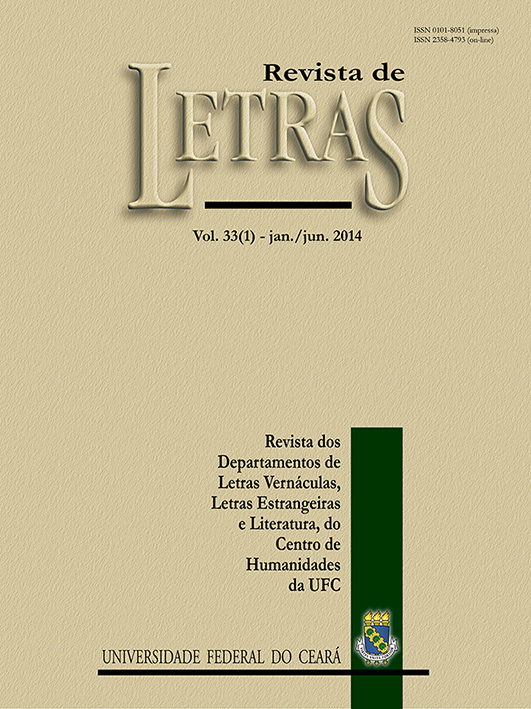ENFRAQUECIMENTO DAS FRICATIVAS SONORAS NA FALA DO CEARÁ
Resumo
Este artigo trata do enfraquecimento das consoantes fricativas sonoras do português no Ceará, onde/v/, /z/ e /ʒ/, como em ‘estava’, ‘desde’ e ‘já’, são realizadas também como som glotal sonoro [ɦ] ouapagado. O som, melhor classificado como murmurado (SCHUBIGER, 1977, p. 90; LADEFOGED,1975, p. 129), pertence a uma família de fricativos que têm no Brasil membros como [h], [χ], [ʁ], [x]e [ɣ] e é semelhante ao correspondente ao /R/ grafado ‘rr’ ou ‘r’ em início de palavra. Esse enfraquecimentonão havia sido investigado com critérios bem definidos, embora tenha sido abordado porautores como Martinz de Aguiar (1937, p. 290), Silveira Bueno (1944, p. 22) e Serafim da Silva Neto(1979, p. 627), que mostraram sua associação a certas classes sociais e sua estigmatização. A pesquisafoi realizada na zona urbana de Fortaleza, com dez falantes de 10 a 42 anos, tendo como objetivosdeterminar os contextos linguísticos e pragmáticos condicionantes e medir o nível de estigmatizaçãodo fenômeno, através da aplicação de um teste de atitudes linguísticas a informantes de nível universitáriocom iniciação em Linguística, que julgaram frases e tentaram caracterizar os falantes quantoà escolaridade e a posição social no mercado ocupacional. Os dados, submetidos ao programaSWAMINC-VARBRUL (NARO; VOTRE, 1980) demonstraram que os fatores mais influentes nofenômeno eram lexicais e pragmáticos, que a usualidade é importante para o enfraquecimento e queos itens mais atingidos são os morfemas gramaticais, sendo mais resistentes os itens mais relevantesinformacionalmente e menos utilizados. Verificou-se também que a menor formalidade e a fala menosmonitorada favorecem o “heização” e o apagamento, que a maior usualidade de um item parece facilitara aceitação de seu enfraquecimento.
Palavras-chave: Fonética do português; enfraquecimento de fricativas; dialeto cearense.
ABSTRACT
This article deals with the weakening of the voiced fricative consonants of the Portuguese languageCeara, where /v/, /z/,and /ʒ/, as in ‘estava’, ‘desde’ e ‘já’, can be realized also as voiced glottal sound [ɦ] or erased. The sound, better classified as murmured (SCHUBIGER, 1977, p.90; LADEFOGED, 1975, p. 129), belongs to a family of fricatives that has in Brazil memberslike [h], [χ], [ʁ], [x] and [ɣ], and is similar to the corresponding to /R/ spelt ‘rr’ or ‘r’ at thebeginning of words. This weakening had not been investigated with well-defined criteria, althoughit had been approached by authors like Martinz de Aguiar (1937, p. 290), Silveira Bueno (1944,p. 22) and Serafim da Silva Neto (1979, p. 627), that showed its association to certain socialclasses and their stigmatization. The research was carried on in the urban area of Fortaleza,with 10 speakers from 10 to 42 years of age, having as objectives to determine the linguisticscontexts and pragmatic conditioning and measure the level of stigmatization of the phenomenonby applying a test of linguistic attitudes to university level informers, with some Linguistic knowledge,that evaluated sentences and tried to characterize the speakers concerning schoolingand social position in the occupational market. The data were submitted to the SWAMINCVARBRULprogram (NARO; VOTRE, 1980) and demonstrated the most influent factors in thephenomenon were lexical and pragmatic ones, that the usuality is important to the weakeningand that the most struck items are the grammatical morphemes, being more resistent those itemswith more informational relevance and less use. It was also noticed that the smallest formalityand the less monitored speech favor the “heização” and the erasing, that the larger usuality ofan item seems to make easier the acceptance of its weakening.
Key words: Phonetics of Portuguse; fricative weakening; Cearense dialect.
Downloads
Downloads
Como Citar
Edição
Seção
Licença
Autores que publicam nesta revista concordam com os seguintes termos:- Autores mantêm os direitos autorais e concedem à revista o direito de primeira publicação, com o trabalho simultaneamente licenciado sob a Licença Creative Commons Attribution que permite o compartilhamento do trabalho com reconhecimento da autoria e publicação inicial nesta revista.
- Autores têm autorização para assumir contratos adicionais separadamente, para distribuição não-exclusiva da versão do trabalho publicada nesta revista (ex.: publicar em repositório institucional ou como capítulo de livro), com reconhecimento de autoria e publicação inicial nesta revista.
- Autores têm permissão e são estimulados a publicar e distribuir seu trabalho online (ex.: em repositórios institucionais ou na sua página pessoal) a qualquer ponto antes ou durante o processo editorial, já que isso pode gerar alterações produtivas, bem como aumentar o impacto e a citação do trabalho publicado (Veja O Efeito do Acesso Livre).

.png)






.png)
